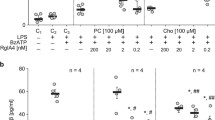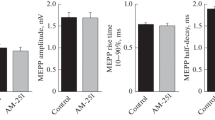Summary
-
1.
Effects of bath-applied recombinant human interleukin-1 (rhIL-1) and interleukin-2 (rhIL-2) on the acetylcholine (ACh)-induced K+ current recorded from identified neurons (R9 and R10) ofAplysia kurodai were investigated with voltage-clamp and pressure ejection techniques.
-
2.
Bath-applied rhIL-1 and rhIL-2 (10–40 U/ml) reduced the ACh-induced current in the neurons without affecting the resting membrane conductance and holding current.
-
3.
The suppressing effects of these cytokines on the current were completely reversible.
-
4.
Heat-inactivated rhIL-1 and rhIL-2 were without effect.
-
5.
These results suggest that the immunomodulators, IL-1 and IL-2, can modulate the ACh-induced response in the nervous system.
Similar content being viewed by others
References
Beckner, S. K., and Farrar, W. L. (1986). Interleukin-2 modulation of adenylate cyclase. Potential role of protein kinase C.J. Biol. Chem. 2613043–3047.
Dafny, N., Prieto-Gomez, B., and Retes-Vazquez, C. (1985). Does the immune system communicate with the central nervous system? Interferon modifies central neuron activity.J. Neuroimmunol. 91–12.
Dinarello, C. A. (1986). Multiple biological properties of recombinant human interleukin 1 (beta).Immunology 172301–305.
Evans, S. W., Beckner, S. K., and Farrar, W. L. (1987). Stimulation of specific GTP binding and hydrolysis activities in lymphocyte membrane by interleukin-2.Nature 325166–168.
Farrar, W. L., and Andersen, W. B. (1985). Interleukin-2 stimulates association of protein kinase C with plasma membrane.Nature 315233–235.
Farrar, W. L., Hill, J. M., Harle-Bellan, A., and Vinocur, M. (1987). The immunological brain.Immunol. Rev. 100361–378.
Fontana, A., Kristensen, F., Dubs, R., Gemsa, D., and Weber, E. (1982). Production of prostaglandin E and an interleukin-1 like factor by cultured astrocytes and C6 glioma cells.J. Immunol. 1292413–2419.
Fontana, A., Weber, E., and Dayer, J.-M. (1984). Synthesis of interleukin 1/endogenous pyrogen in the brain of endotoxin-treated mice: A step in fever induction?J. Immunol. 1331696–1698.
Frazier, W. T., Kandel, E. R., Kupfermann, L., Waziri, R., and Coggeshall, R. E. (1967). Morphological and functional properties of identified neurons in the abdominal ganglion ofAplysia californica.J. Neurophysiol. 301288–1351.
Giulian, D., and Lachman, L. B. (1982). Interleukin-1 stimulation of astroglial proliferation after brain injury.Science 228497–499.
Giulian, D., Baker, T. J., Shih, L.-C. N., and Lachman, B. (1986). Interleukin-1 of the central nervous system is produced by ameboid microglia.J. Exp. Med. 164594–604.
Giulian, D., Young, D. G., and Woodward, J. (1988). Interleukin-1 is an astroglial growth factor in the developing brain.J. Neurosci. 8709–714.
Hori, T., Shibata, M., Nakashima, T., Yamasaki, M., Asami, A., Asami, T., and Koga, H. (1988). Effects of interleukin-1 and arachidonate on the preoptic and anterior hypothalamic neurons.Brain Res. Bull. 2075–82.
Nakashima, T., Hori, T., Kuriyama, K., and Mizuno, K. (1989). Recombinant human interleukin-1-β alters the activity of preoptic thermosensitive neurons in vitro.Brain Res. Bull. 23209–213.
Oomura, Y. (1988). Chemical and neuronal control of feeding motivation.Physiol. Behav. 44555–560.
Plata-Salaman, C. R., Oomura, Y., and Kai, Y. (1988). Tumor necrosis factor and interleukin-1-β: Suppression of food intake by direct action in the central nervous system.Brain Res. 448106–114.
Sawada, M., Hara, N., and Maeno, T. (1991a). Ionic mechanism of the outward current induced by extracellular ejection of interleukin-1 onto identified neurons ofAplysia.Brain Res. 545248–256.
Sawada, M., Hara, N., and Maeno, T. (1991b). Tumor necrosis factor reduces the ACh-induced outward current in identifiedAplysia neuons.Neurosci. Lett. 131217–220.
Smith, K. A. (1988). Interleukin-2: Inception, impact, and implications.Science 2401169–1176.
Solomon, G. F. (1987). Psychoneuroimmunology: Interactions between central nervous system and immune system.J. Neurosci. Res. 181–9.
Tancredi, V., Zona, C., Velotti, F., Eusebi, F., and Santoni, A. (1990). Interleukin-2 suppresses established long-term potentiation and inhibits its induction in the rat hippocampus.Brain Res. 525149–151.
Zona, C., Palma, E., Santoni, A., Grassi, F., and Eusebi, F. (1990). Interleukin-2 reduces voltage-activated Na+-currents in embryonic rat hippocampal neurons.Soc. Neurosci. Abstr. 16181.
Author information
Authors and Affiliations
Rights and permissions
About this article
Cite this article
Sawada, M., Hara, N. & Maeno, T. Reduction of the acetylcholine-induced K+ current in identifiedAplysia neurons by human interleukin-1 and interleukin-2. Cell Mol Neurobiol 12, 439–445 (1992). https://doi.org/10.1007/BF00711544
Received:
Accepted:
Issue Date:
DOI: https://doi.org/10.1007/BF00711544




